Reproducibility and evaluation of the result in the Spanish Classical Guitar Making
luthiery!
Vladimir Druzhinin and Timofey Tkach / March 23 2021
The consistent reproduction of a previously achieved result is one of a luthier’s key goals. First and foremost, this applies to such basic properties of the instrument as the character and class of sound. The ability to objectively evaluate and reproduce the result is a precondition for developing and improving mastery.
Our article aims to discuss the problem of reproducing the sound of an instrument and to formulate a general practical approach to solving it. We also define the basic notions and describe the criteria for evaluating the sound of the guitar.
*We are grateful to Guitar Salon International and Alexander Pokasovsky for their valuable assistance in preparing the English translation of the article.
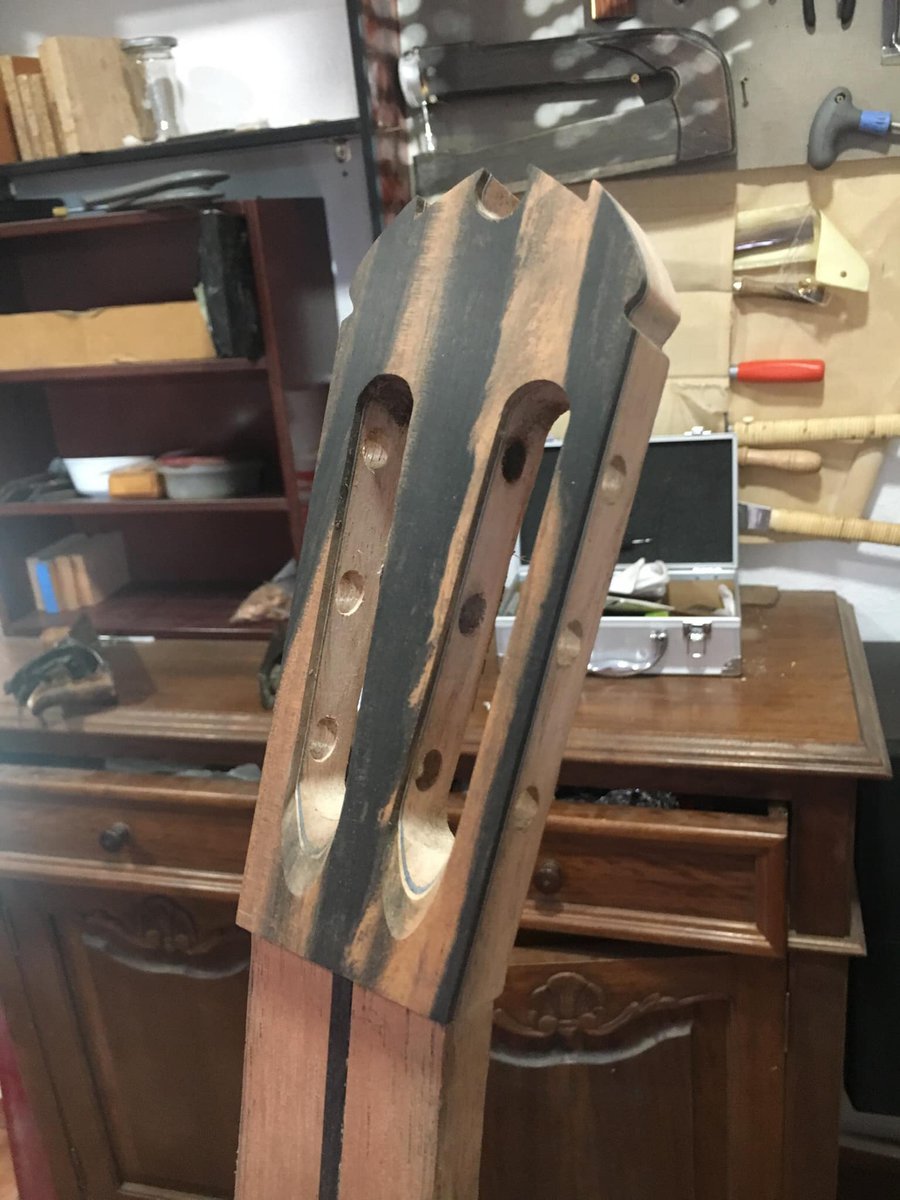
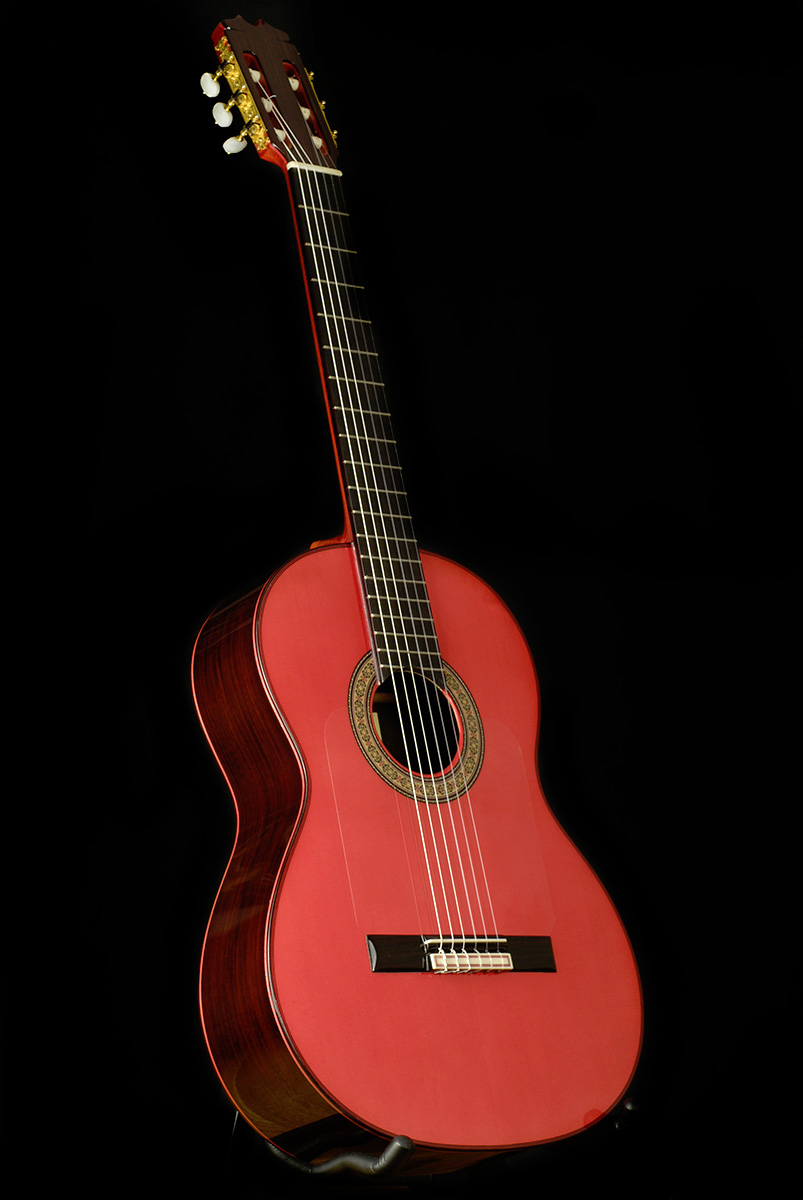
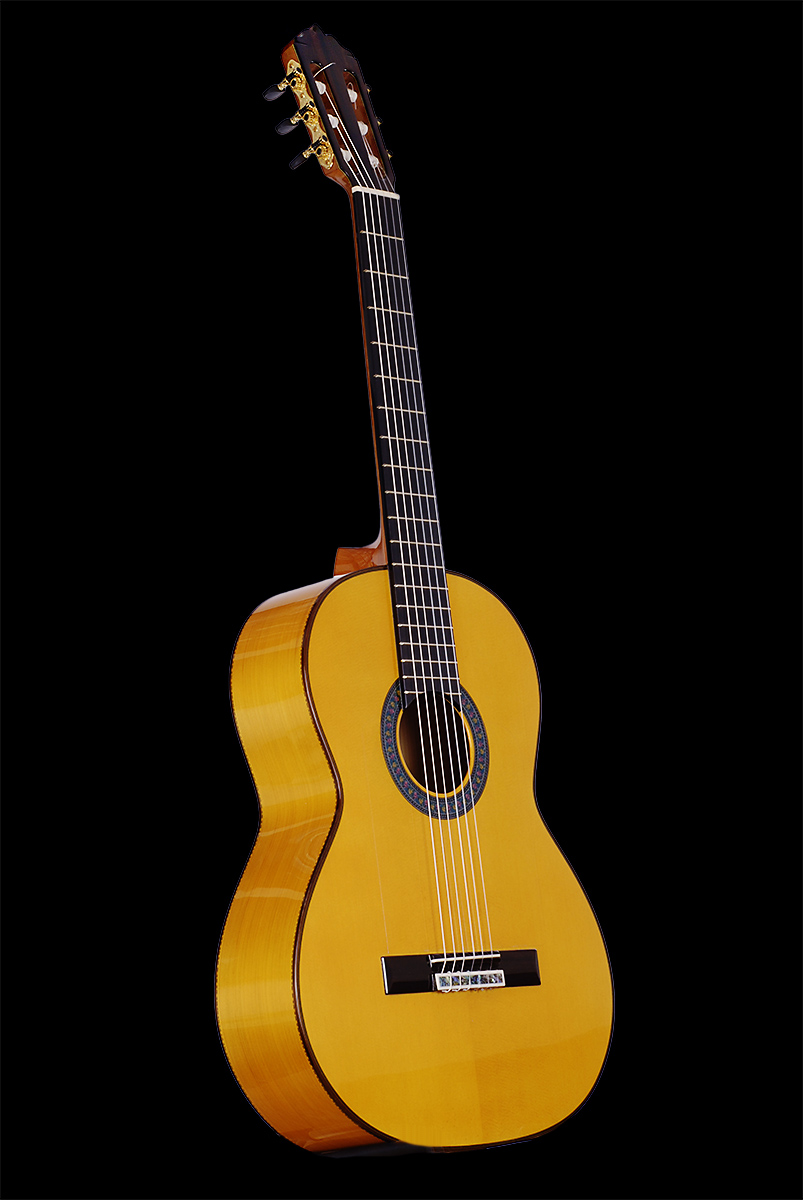
Luthiers work with wood. Resting upon knowledge and tradition, using carpentry skills and artistic taste, they build instruments whose aesthetics and appearance are important, but which are not an end in itself. From a luthier’s point of view, the instrument is a mechanism. It lends itself to measurement, weighing, and other objective methods of examination. Its parts are connected and interact with each other. The challenge is to get them to work coordinately. Achieving this result requires both a technological method and evaluation criteria.
For luthiers, the main objective of building instruments is to provide musicians with a medium: a sound potential through which to realize the artistic ideas.
Musicians tend to evaluate instruments mostly based on their sound and tactile sensations which they experience during playing. Their judgments about sound quality are largely based on their individual feelings and impressions, that is, they are subjective. Nevertheless, we can observe that, from a historical perspective, the musical community comes to a consensus in the evaluation of certain instruments.
There are many examples of this, but the most striking is the violin. Today, the general standpoint in the professional environment is that the best violins are Italian instruments made between the 16th–18th century. Modern luthiers are guided in their work by Italians of that period. The same applies to classical guitar, for which the Spanish school of the 19th–20th centuries is a model. This school is a product of Spanish folk music tradition and the laborious work of many generations of craftsmen who strove to create an instrument design that would best meet the demands of musicians.
Both the Italian violin and the Spanish guitar have organically entwined with the context of various national cultures and musical trends, becoming the benchmarks of sound. Such unanimous consent by people all over the world suggests that there are common (and therefore objective) criteria for assessing the sound quality.
When appealing to the building of the classical guitar, we’ve got as our starting point the already established Spanish school. Consequently, our task is to understand how the craftsmen of the school achieved the result and what qualities of the sound contributed to the fact that their instruments conquered the world. We need to dissect sound as a physical phenomenon and understand how it is organized. We need to understand the relation between sound properties and its perception. Moreover, we need to develop criteria to evaluate the sound. They have to be objective if we seek for reliable analysis. So, we set ourselves the task to realize and formulate the method of constructing a Spanish guitar which will allow us to achieve the result and to reproduce it steadily. We rely on the research of Spanish instruments as well as on our own experience in constructing guitars.
Many of the terms we use in this article are commonly known among musicians and luthiers. However, their meaning is not often precisely defined and can be ambiguous. To avoid any confusion, we formulated the following definitions:
Sound formation means processes going on in a musical instrument, thanks to which the performer’s impact (plucking) is transformed into sound (air vibrations).
Sound character combines the specific features which are peculiar to the sound of a particular design of a musical instrument and which allow identifying that design.
These features make it possible to distinguish the sound of different musical instruments even while listening to the same musical material. This is also true for various guitar designs. While having much in common, the sound of each has specific characteristics. For a musician, during a performance, the sound is also connected with tactile sensations which are also specific and play a major role in the perception of the instrument.
The inseparable link between auditory perception and consciousness allows us both to distinguish and to perceive as a whole the large variety of objective sound characteristics, which we are able to evaluate. They all add up to a general picture and form an artistic image in the mind, subjective impressions and evaluation. The auditory analysis may turn complicated, as we have to separate the objective data in order to draw reliable conclusions. Certain training makes it possible to learn how to use our hearing as the tool for objective analysis of the sound. This skill is necessary to solve problems we face constructing a guitar.
Guitar design refers to its detailed structural setup: the way of assembly, shape, dimensions and disposition of all its parts.
We need to divide the changes introduced to the design according to their effect on the sound character of the instrument. Keeping up the sound character is the criterion for the invariability of the design. A slight variation in the size of certain elements (bracing heights, neck or top/back thicknesses, sound hole diameter, etc.) does not fundamentally change the sound character. We hereby consider the design unchanged.
As a modification of the design, we treat more serious interventions that fundamentally change the way it works (displacement of the bracing or the bars, changes in the principle of their arrangement, changes in the body proportions, etc.). The allowable range of size variations that do not overstep the limits of the design is determined by the specific working conditions in each case. For example, a successive increase in the height of the fan bracing at some point will change the proportions of their cross-section and radically increase their stiffness. Its balance in the soundboard will change fundamentally. This, undoubtedly, would already be a significant change, violating the design.
Tuning is adjusting the elasticity and mass distributions in the instrument, carried out by certain manipulations with the dimensions of its parts, without changing the design.
Sound class is a qualitative assessment of the sound based on the most important objective characteristics, such as:
If applicable, we evaluate the uniformity of each of the above characteristics across the dynamic range and all registers of the guitar.
A detailed description of the criteria for evaluating the sound is provided in the next section.
We linked the design together with the sound character of the guitar. The sound class is determined by the accuracy in matching and balancing the parts of the instrument during its tuning.

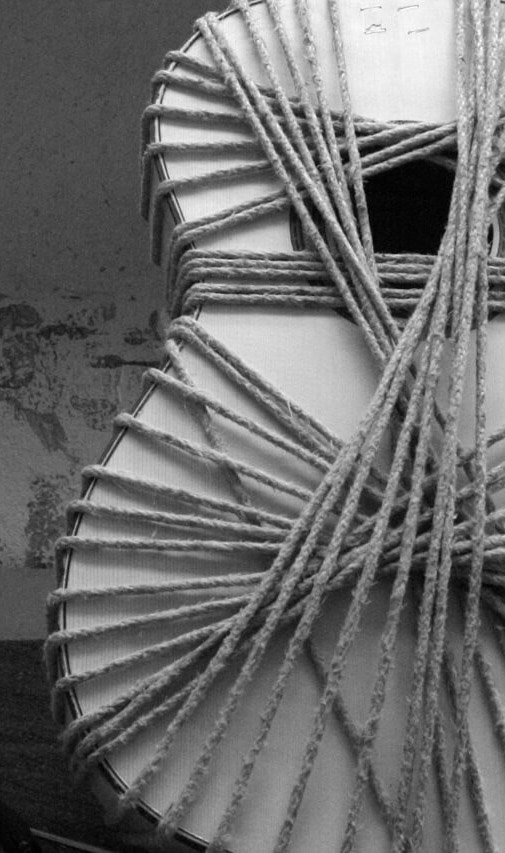

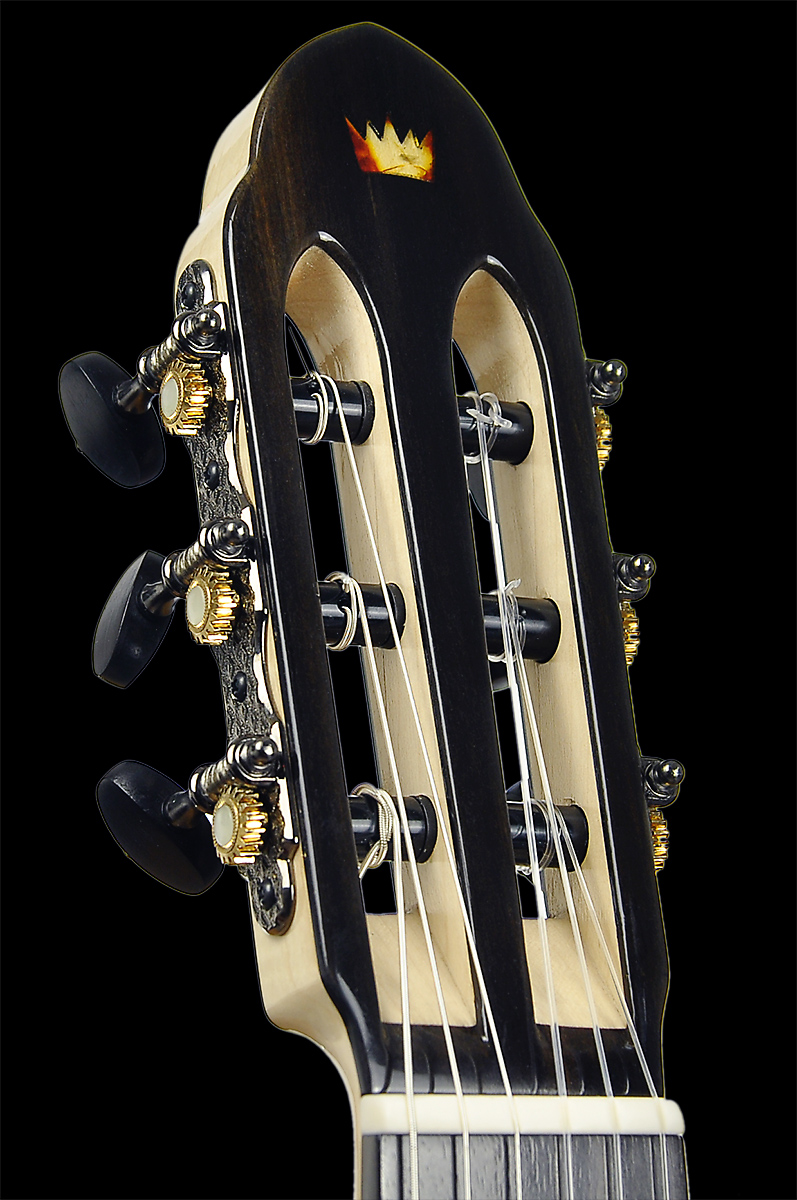
When we hear or play an instrument, we perceive its sound as a whole and often describe it in some general terms that are metaphorical and reflect our subjective emotional perception (soft, sharp, glassy, viscous, sweet, flowing, singing, warm, cold, etc.) This way of assessing sound is good for artistic description, but from a practical point of view, it is useless.
It would be difficult to describe the way of achieving a sweet sound because such terms express individual feelings and experiences. Nevertheless, at the heart of subjective perception, there are a number of basic objective characteristics of the sound, which we need to sort out in order to have criteria for meaningful evaluation of our own work.
A simple harmonic oscillation has only two characteristics that change over time: frequency and amplitude. The sound of a guitar is a result of the development of complex oscillating processes. In this case, we can distinguish between the sound characteristics associated with sound formation (development in time), timbre composition, as well as dynamic characteristics.
It should be noted that the skills of analysis of an instrument sound require training; also, the experience of conscious listening is necessary. It could be quite challenging to give a quantitative assessment (e. g. on a 10-point scale) for each of the criteria described. Often, a comparative evaluation of several guitars allows for a clearer distinction and understanding of the individual characteristics of the sound. Listening to recordings and playing high-class instruments might help with building up the personal listening expertise necessary for objective analysis.
If there are clear criteria, it is possible to evaluate how well the guitar sound is organized, compare instruments to each other, and evaluate the sound class.
The sound of a guitar does not form or fade out instantly. Between the plucking and the sound that reaches our ears, there is a development of complex vibrations of the string, the guitar body, the surrounding and enclosed air. The moment of plucking is the only contact (excluding vibrato and other left-hand techniques) between the player and the string when the player can influence the sound. Any sound development past that point is out of the performer’s control and is completely dependent on the sound formation in the guitar. This is why attack (sound formation) speed and decay (sound fading) duration are so important.
Especially when the texture of music involves rapid note changes (tremolo, rasgueado, arpeggio, trills, and rapid passages). It is vital for the performer how quickly the instrument gets fully engaged in the oscillation. The faster it happens, the more focused, clearer, and colorful the sound will be. The attack quality is of great importance for the playing comfort. A slow attack leads to excessive reflex tension in the hands due to inconsistency between movements and guitar response. On the contrary, a quick attack creates a feeling of ease, a good connection with the instrument. The hand movements are coordinated with the sound. An instrument with a fast attack responds well to various left-hand playing technics (vibrato, legato, trills).
No less important is the decay. It is widely thought that a guitar sound should be long and sustained. Excessive sustain, however, causes control problems in the right hand: when the notes change quickly they do not have enough time to fade out due to the inertia of the instrument.
A fast attack and a relatively fast decay are characteristic of the classical guitar sound. This makes it possible, regardless of the musical texture, to achieve a fluent and connected phrase (each sound appears without delay) and to avoid intermixing when quickly switching from one note to another. The longer duration is achieved not so much by the sustain as by the accent, highlighting the desired note from the context of the composition.
Our hearing adapts quite easily to different volume levels. Loudness perception is relative. Even loud sounds (within reasonable limits, of course) begin to be perceived as the norm if the volume range is relatively narrow. Of great importance for dynamic perception is also the level of noise, such as extraneous sounds which are interfering and competing with the “useful” sound.
Thus, the expressive means for the musician is not the loudness itself, but the dynamic range around the average level, achieved by playing gently with moderate plucking effort. From this level, we have a span towards pianissimo, and a span towards fortissimo. The larger this range, the more expressively the emphasized sound is perceived, and the more potential the performer gets to reveal the emotional intensity of the piece by gradually changing the volume level (crescendo, diminuendo).
The correlation between plucking effort and volume (dynamic controllability) is vital for playing comfort. If a small change in effort results in a large change in volume, or, conversely, a large effort range has little effect on volume, it becomes extremely difficult to use dynamic nuances and accents. When a smooth rise in the performer’s natural range of effort matches the dynamic rise in the range of the instrument, the guitar is easy to play and is naturally and intuitively controlled.
The timbre is the sound color. Each sound that we produce with an instrument is a chord consisting of overtones (partials that are higher in pitch than the fundamental tone of the note being produced). Ideally, overtones are harmonics to the fundamental tone, that is, divisible by its frequency. For example, the fundamental tone of the “A” note (5th open string) has a frequency of 110 Hz and it is the first harmonic. Further harmonics are calculated by multiplying that frequency by the harmonic number (220, 330, 440, 550, 660 Hz, etc.) When emitted at the same time these notes build up various intervals between them (frequency ratios of 1=2 for an octave, 2=3 for a fifth, 3=4 for a fourth, 4=5 for a major third, etc.), and combined all together they form a sound color. The color depends on the amplitude, decay, pitch, and number of harmonics. Disharmonious overtones may also be present. The more of them, the less pleasant the color of the sound is perceived.
An important expressive means for a musician is timbre variability. Here we evaluate how easily the instrument responds to changes in the position of the right hand, plucking angle, plucking speed, and vibrato. Depending on the technique and nuances of sound production, the string generates overtones in different proportions, and this should have an effect on the sound of the instrument.
At this point, it is appropriate to recall the attack of the guitar: The faster all parts of the instrument can become engaged in the oscillation, the more harmonics can participate in the sound in a minimal amount of time. This reveals the connection between timbre and attack.
Evenness is a criterion that applies to all of the sound characteristics described above and combines them. It describes the sound quality of the instrument as a whole. Evenness refers to the similarity of the sound characteristics of all notes on the guitar neck (evenness in all registers and in the dynamic range). The attack, as well as the decay, timbre, dynamic controllability, and range should be similar across all registers. Only such an instrument will be manageable and predictable for the musician.
Assessing the evenness of the sound can be a bit of a challenge. For example, playing a chromatic scale throughout the guitar range does not allow one to compare notes from different registers. By the time we get to the upper notes, we forget the sound at the bottom of the range. A good way to check whether an instrument is “even” is to perform music with a texture in which notes of different registers sound consecutive or simultaneous. For example, you can assess the guitar’s response by playing one chord in different positions, wide-spaced (e. g. open bass and harmony at the top of the range), or open voicing chords. If you hear an explicit dominance of some notes over others or the attack, decay, and timbre in a chord are not uniform, then you’re dealing with a problematic instrument.
The evenness across the dynamic range in different registers is best tested by performing an arpeggio that involves as many positions on the fingerboard as possible. From our point of view, the best example is Etude .1 by Heitor Villa-Lobos. If there are no difficulties with smoothly changing the volume, and if all notes sound equivalent within a chord, then the evenness is all right.
It is the evenness (and therefore predictability) that enables a musician to realize the full potential of the instrument in harmonic texture and voice leading, as well as in their combination, which is very characteristic of the guitar.
A luthier’s working principle — building a guitar by hand — allows one to treat to the crafting of each component in all stages of assembly with the utmost attention and thoroughness. There are a lot of challenges: from the overall planning and justification of the instrument’s structural design to the purely technical challenges of making individual parts. This work needs to be systematized; That is, to develop a workflow that allows you to consciously follow a certain sequence, with a methodical justification for all of the manipulations performed at one stage or another.
The correctness of the systematic approach is evidenced by the ability to consistently reproduce the result. Indeed, if the exact observance of the technological process does not lead us to the reproduction of the result, then it indicates that an error must have been made at some point, and there are significant factors that remain outside of our control.
Now we call the result the sound of a guitar in the most general sense. Later on, in the course of our discussion, we will have to clarify this notion. So let’s start by checking whether or not it is possible to exactly copy the sound of a reference instrument.
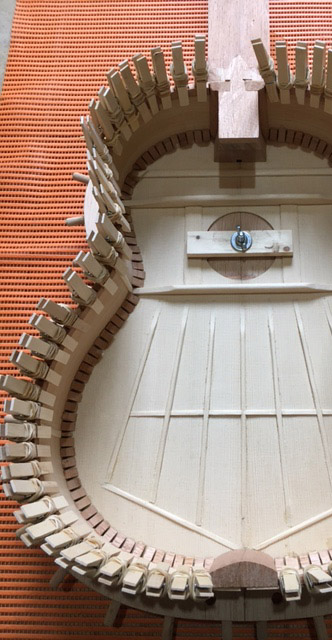
A guitar is a material object. All processes running in it follow the laws of physics. The sound of a guitar, in all its subtle aspects, is nothing mor than a result of numerous oscillating processes developing within it. These processes, for their part, are determined by two factors:
The task of accurately reproducing a sound thus comes down to their simultaneous replication. We have purposely excluded a further factor that affects the sound: The influence of environmental conditions. We will consider them as constants. For a mental experiment, it is not a problem to place two guitars in the same environment for comparison.
The important material properties for us are the mass and elasticity or, to be more specific, their distributions in the instrument. This is what determines the oscillation parameters of any part of the guitar, just as mass and stiffness determine the swing of a simple spring oscillator. Wood is a structured natural material. Its density and elasticity are not uniformly distributed and can vary over a wide range of values within a single blank, not to mention sets of material taken from different trees (the properties of a particular wood blank depend on the climate and environmental conditions of the particular tree, the saw cut nuances as well as other factors that cannot be controlled. The structure of two trees growing in the same place and apparently under same environmental conditions can significantly differ.)
It is impossible to copy the properties and structure of wood because of its natural uniqueness. Every new instrument is always built with materials that differ significantly in their properties and structure from those of the reference instrument. This means that exact reproducing of the sound cannot be achieved even by the most careful copying of the design: The physical properties of its elements will be different, and so will the parameters of the oscillation processes that determine the sound. Therefore, we need to reconsider our goal.
We set ourselves the task to achieve the sound that is as close to the reference as possible. We have to build the new instrument in a way that the oscillating processes within it would replicate most closely those in the reference instrument. Therefore, for a new guitar, we need to achieve the elasticity and mass distributions as close as possible to the reference.
To make so, it is necessary and sufficient to satisfy two conditions at a time: firstly, to reproduce the design and secondly, to perform tuning of it (that is, working on the elasticity and mass distributions in the instrument without changing its design). Working with dimensions is the only accessible way by which we can adjust the elasticity and mass parameters. It should be recalled that we started by setting some freedom of variation in dimensions as we gave the definition of the design.
So, we have formulated the task to be accomplished when working on each new instrument. The result we define as the character and class of the sound. And the task of reproducing the result comes down to reproducing the guitar design and performing the tuning of it.
design reproducing -> sound character
design tuning -> sound class
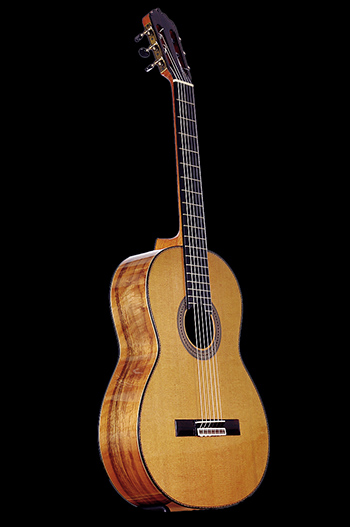
We formulate a general methodical approach to guitar building as follow:
In today’s world, it often happens that the achievements of one national culture become a province of all mankind. This is certainly true of the classical Spanish guitar. By researching and building it, we hope to contribute our share to preserve the heritage of this great school for future generations.
Authors: Vladimir Druzhinin and Timofey Tkach / March 23 2021